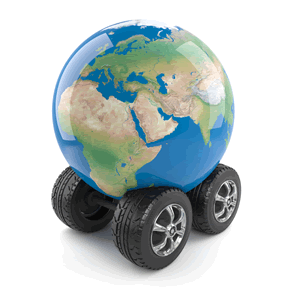Q&A with TE: Cable and Assemblies for Transportation Applications
Representatives from TE Connectivity’s Automotive Cable Assembly Product Team answer your questions about cable and assemblies for transportation applications.
 Q: What are the key areas of transportation that are driving the development of new cable products?
Q: What are the key areas of transportation that are driving the development of new cable products?
A: Infotainment systems, hybrid and electric mobility, driver assistance, driver safety, and human machine interfaces (HMI) are all contributing to the development of new cable products and even the standardization of others such as Ethernet.
For example, years ago Ethernet was initially used by automakers for on-board diagnostics only. But as automotive electronics advanced, the technology has found a place in advanced driver assistance systems, safety, and infotainment platforms. Organizations like Open Alliance and IEEE work with car manufacturers and companies like TE to create new auto networking specifications to complement these newer applications.
Q: What are the most serious challenges facing cable manufacturers right now?
A: With advances in traditional vehicle systems (e.g. electronic steering) and consumer adoption of modern interconnected technology (e.g. satellite radio), automotive OEMs are under enormous pressure to add electronic functionality to today’s vehicles. This type of new functionality requires OEMs to increase the number of electrical circuits between computers, input/output devices, and displays and switching systems.
The reality, however, is that packaging space for this type of additional wiring has not increased and therefore managing cost, space, and weight targets continues to present a major challenge. The competing pressures of functionality and resources have ultimately increased the demand for the miniaturization of the connection system. The change from copper to aluminum wires has also become a major consideration.
Especially for North American manufacturers, meeting North American OEM standards has been extremely challenging given the lack of prior adoption of miniaturization in the US. Many organizations have approached miniaturization by taking their larger connectors and simply scaling them down; however, this approach is problematic since the terminal is now smaller than the wire itself and the tight spacing makes it impossible to form the alignment and retention features in the conventional way.
Over the last few years, TE has worked collaboratively across markets like Japan to address this auto miniaturization trend, building a system that reduces the number of components in our designs rather than simply downsizing the system altogether. This allows us to manufacture the parts that meet industry standards without sacrificing manufacturability, robustness, and reliability.
Q: Are there any regulations or standards that are specific to the transportation industry of which design engineers should be aware?
A: Engineers should be aware of the following:
- The mechanical demands for automotives require stringent testing including temperature tests, vibration tests, and environmental tests. This type of testing is not as common for industrial applications.
- Production Part Approval Process (PPAP) requirements are currently used in the automotive supply chain for establishing confidence in component suppliers and their production processes. PPAP is in place to essentially make sure that component suppliers have developed their design and production processes to meet their client’s requirements to minimize the risk of failure. The Automotive Industry Action Group (AIAG) created this to help encourage the use of common terminology and standard forms to document project status.
- USCAR is a national organization that oversees industry wide research and development.
- AK Standards
Q: What have been some of the most important developments in cable and wire for transportation applications in the last year or so?
A: As mentioned earlier, recently miniaturization has proved to be a tremendous development as well as a challenge for OEM manufacturers. This has inadvertently created the need for automatic processes associated with miniaturization to manage crimping as well as the insertion of terminals to connectors. There is also a major effort to create new miniaturization standards within the North American market.
Separately, there has been a growing trend to implement aluminum cable and terminals within automotive designs. Aluminum, as compared to copper, can reduce vehicle weight and CO2 emissions; it’s a more stable and lower-cost alternative; and also addresses many safety issues such as corrosion. TE, for example, recently brought to market our LITEALUM wire crimp, which connects aluminum wires to standard, proven copper alloy terminals in motor vehicles. The technology enables an easy transition from copper to aluminum wire, and has all of the benefits listed above.
Q: Are wire harnesses and cable assemblies for transportation most often sourced out, or do vehicle OEMs tend to design and build them themselves? Why is this a bad or good idea?
A: Wire harnesses and cable assemblies are mainly designed by OEMs. They are typically sourced by the tiers based on the particular OEM car design requirements.
Q: What are the most important considerations for a design engineer who is specifying cable for a transportation application?
A: There are several things to consider including temperature level of the various applications, which can vary from industry to industry. Miniaturization, weight reduction, fluid resistance, the compatibility of materials between wires, tapes, and tubes, and material costs should all be top of mind as well.
Q: Is cable basically the same for all forms of transport, or do different types of vehicles/equipment have proprietary products?
A: It is mainly the same—there is very little variance across vehicles/equipment.
Q: What do you see happening product-wise in the transportation cable market over the next year or so?
A: There will be an increasing expansion of cable due to the IoT movement and the addition of electronics into vehicles. There will be a decrease in the cross-section for signal application as well as a shift from copper to aluminum wires (to decrease weight). There will also be a focus on wires that can accommodate higher temperatures, as more applications are added under the hood and temperatures in that area increase.
Respondents Mike Aiello, Xavier Gerard, and Jose Pano are part of TE Connectivity’s Automotive Cable Assembly Product Team.





